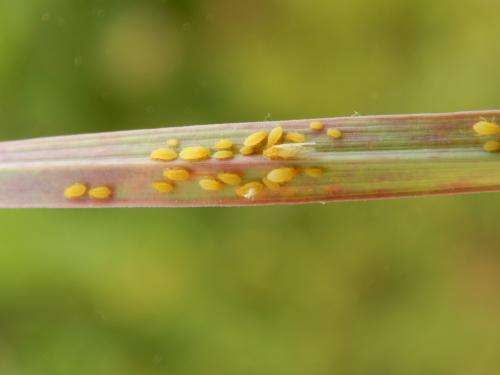Yellow sugarcane aphid detected in continental Europe

Aphids are a kind of insect that typically lives on the aerial parts of plants, feeding on the sap that flows through the phloem with a specialized buccal apparatus. That is why they are considered pests in agricultural crops.
Recently, Carlos Hernández-Castellano, student of the MSc in Terrestrial Ecology at the Universitat Autònoma de Barcelona and research collaborator of the Centre for Ecological Research and Forestry Applications, and Nicolás Pérez Hidalgo, researcher from the University of León, discovered a new aphid species in the European continent, in La Selva del Camp (province of Tarragona) and Blanes (province of Girona) (NE Spain).
This aphid, called Sipha flava, is native to North America, although it has expanded throughout South and Central America. In these regions, it is known as "the yellow sugarcane aphid," and is a known pest of this crop, feeding on the plant and acting as a virus vector, leading to yield reduction.
The researchers consider the possibility that the species has reached continental Europe from the Southern Iberian Peninsula as a result of sugarcane crop expansion in northern Africa.
"This crop is rather marginal in European Continent, so Sipha flava is not expected to become a sugarcane pest in this zone. However, we know that it feeds on several species from the same family, in this case grasses, and it is unknown to what extent the aphid could represent a threat to these kinds of crops in Europe, such as rice or corn," Carlos Hernández-Castellano explains. Therefore, a distribution map of this species in Europe is needed in order to evaluate its potential pest behaviour, implementing the principle of precaution.
In addition to the new species in the European continent, researchers also discovered the first case in Eurasia and North Africa of an aphid feeding on a plant from the genus Hyparrhenia (also from the grass family), and also contributed the first evidence that this aphid is attended by ants – ants and aphids tend to establish mutualistic relationships, in which ants offer protection in exchange for honeydew excreted by the aphids.
This discovery, researchers say, highlights the increasing threat of invasive species, a booming phenomenon caused by globalisation, leading not only to agricultural issues but also rising as a major cause of biodiversity loss in the world, just behind habitat destruction in importance.
The researchers point out that, although the finding supposes an increase in the diversity knowledge of this aphid genera—to date just 10 species of this genus were known in Europe, and only 3 in the Iberian Peninsula—the alert message is clear.
The discovery came during a sampling campaign which aimed to study the insect trophic web of an organic citrus grove. The work was carried out in the context of the Fauna Iberica Project, which aims to catalogue and establish the distribution of animal diversity in the Iberian Peninsula in order to guarantee its conservation.
More information: The study is available online: redia.it/images/stories/pdf2014/Redia_97_2014_16%20Hernandez%20%20et%20al__.pdf
Provided by Universitat Autonoma de Barcelona





















